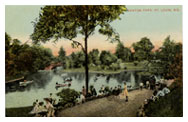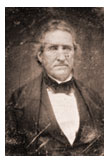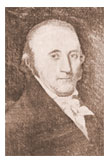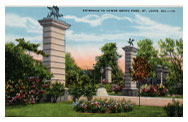Neighborhood Histories
St. Louis has a long and important history part of which is represented in the people who settled here, built their homes and businesses, and raised their families. As we often discover while renovating a property, they left behind a beautiful legacy in the structures. Here we offer a little background on the neighborhoods where we work.
Benton Park

Early postcard of Benton Park
This neighborhood gets its name from the park that sits at the southeast corner of South Jefferson Avenue and Arsenal Street. Benton Park, named for Senator Thomas Hart Benton, became a city park in 1866 after having served as a cemetery from 1840 to 1865. This area was originally part of the Cherokee-Lemp neighborhood and contains a large number of historic structures and storefronts.

Thomas Hart Benton
The best-known of these are the Lemp Brewery and the Lemp and Chatillon-De Menil Mansions clustered in the far southeast corner of the neighborhood. The housing stock is widely varied with properties ranging from large, stately homes to the more efficiently-sized abodes where famlies of the working class brewery, brick and construction tradesmen once lived. With all this going for it, the neighborhood was officially declared a Federal Historic District in 1985.
Today the neighborhood is humming with activity. Revitalization here is attracting people who want to buy homes and live in the city. Most of the homes that surround the park or in close proximity have already been rehabbed or are well into the process. Millennium has plans to build The Fleurs-de-Lis a new development that will include condominiums and commercial retail space.
For recreation, this neighborhood has three parks: Benton, Cherokee and Fremont. There are also several cultural and arts events during the year – Art in the Park is a notable mention. Benton Park has wonderful diversity in its many excellent places to wine and dine, shops full of antiques and collectibles and it has become a very dog- and walking-friendly community.
Soulard

Antione Soulard
In the 1790s, the Spanish governor deeded Antoine Soulard some land from the city's common fields. This land was in payment for Soulard's services rendered as surveyor general of Upper Louisiana, and it is how the area got its name. Immigrants came to Soulard beginning with Germans in the mid-1800s. Later they were joined by Czechs, Slovaks, Croatians and Lebanese. The neighborhood's buildings were a mixture of public structures, shops, businesses, churches and residences, despite the passage of time, it retains this diversity of buildings into the present day. Best seen on foot, you can walk the brick-paved alleys as they lead to carriage houses reinvented as a residental home. You will see a large number of historic homes that run the gamut from brewer's mansions to working class row houses. And the decorative friezes, iron storefronts and wrought iron fenced yards sprinkled throughout the area distinguish this very charming neighborhood.
Though there are still many old properties today, it is unfortunate that historic buildings were destroyed to make way for new highways in the 1950s, 60s and 70s. In 1969, a now defunct organization called The Soulard Neighborhood Improvement Association was founded to keep the area from being destroyed any further and in 1972 their dedication resulted in successfully having this historic area bounded by Gravois Avenue, I-55, and Broadway, placed on the National Register of Historic Places. The current neighborhood organization, the Soulard Restoration Group, came into existence in 1974.
Benton Park West
By the 1860s this neighborhood was already a well-established community with several dairies, grocers, carpenters, a blacksmith, a midwife and at least two taverns. It was predominatly a working-class community, but many area businessmen built beautiful homes that are still standing today. And a few of those businesses are still around too, among them: Gravois Planing Mill, Jefferson Tent & Awning Company and the Hat Mart.
The area has a large stock of historic homes, most were built between the 1880s to just past the turn of the century. There are also several storefronts scattered throughout the area and they can be found along Jefferson Avenue, Gravois Avenue and Cherokee Street as well. This neighborhood is also alive with redevelopment activity and has developed a very diverse group of committed residents. In 2005 Benton Park West was added to the National Register of Historic Places as part of the Gravois-Jefferson Streetcar Suburb National Historic District.
Fox Park
Early French settlers originally called this area, "La Petite Prairie." In the 1870s a major brickyard was established on Shenandoah, which lead to the establishment of five other brickyards in the area. Within ten years the lumberyards were established. Building materials were now close at hand and that sparked the development of this area and the influx of immigrants who settled here came because work was plentiful.
 Most of the homes in Fox Park were built from the 1880s to the 1930s and most of the residents were working class families that were first and second-generation German-Americans. The neighborhood reflects this in its abundance of single family, two- and four-family units. There are also many iron storefronts manufactured at the turn of the twentieth century by St. Louis foundries. These storefronts are being redeveloped today for both residential and commercial use.
Most of the homes in Fox Park were built from the 1880s to the 1930s and most of the residents were working class families that were first and second-generation German-Americans. The neighborhood reflects this in its abundance of single family, two- and four-family units. There are also many iron storefronts manufactured at the turn of the twentieth century by St. Louis foundries. These storefronts are being redeveloped today for both residential and commercial use.
Built in 1907 and an obvious flagship of the neighborhood, St. Francis DeSales Catholic Church was placed on the National Historic Register of Historic Places in 1978. The church's 300-foot steeple soars above the skyline and is known as, "the Cathedral of South St. Louis."
Fox Park was officially designated an Historic District in 1985. Its location in the city's landscape is ideal for any city dweller with downtown, Tower Grove Park, the Missouri Botanical Garden, South Grand shops and restaurants, schools and churches barely minutes away. History, affordability and convenience make Fox Park a great place to call home.
Tower Grove East
This area was settled by the French in the early 1700s when it was part of what they referred to as "La Petite Prairie." Around 1800 the common grazing and farm land around St. Louis began to be sold off to private owners. By the middle of that century, German Catholics owned most of the land and they used it for their pasture lands and dairy farms. Eventually blocks were developed and near the end of the century, homes began to appear.

Vintage postcard showing the east entrance
to Tower Grove Park
This neighborhood has a great selection of historic homes that range from small one-story bungalows to grand three-story homes. There are apartment buildings as well and a large inventory of storefronts featuring iron works by most of the early local foundries. The area was primarily a working class neighborhood but it also included a few shopowners that had established their businesses downtown. These entrepreneurs could afford to hire well-known architects to design their homes and they brought in the skilled German craftsmen, so plentiful at that time, to create the accents that decorate the interiors.
Today the neighborhood has evolved into a disparate mix of homeowners, renters and business owners. Any day spent in historic Tower Grove Park will demonstrate that. There are schools, churches, retail stores, restaurants and bars, coffee houses and art galleries and the vibrant and eclectic Grand South Grand shopping area lies just to the south.
